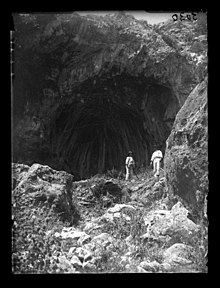Cova Negra
 Cova Negra, 1928 | |
| Region | Province of Valencia |
|---|---|
| Coordinates | 38°57′54″N 0°29′47″W / 38.965046°N 0.496271°W |
| Type | Intermittent settlement |
| History | |
| Periods | Mousterian |
Cova Negra is an archaeological site near the town of Xàtiva in the Province of Valencia, Spain, with remains that show sporadic and short-term occupation by Neanderthals in the Mousterian period.[1]
Location and description
The cave is located in a valley alongside the Albaida river, and an area of 57 hectares around the cave was declared a Cultural Heritage Site. Since 2006 the site is a Municipal Natural Site, also named Cova Negra.
Archaeological finds
The Neanderthals who occupied the area were avid eaters of birds; 247 remains of 18 different bird species were found, especially doves and choughs.[2] Bird consumption in Cova Negra and other caves such as Cueva de Bolomor, Gorham's Cave, and Ibex Cave, prove that the northwestern part of the Mediterranean saw widespread exploitation of "small, fast game".[3]
In 2013, a fragment from an adult parietal bone were found, a cranial fragment from a child, and a child's premolar. By that time, the cave had 25 pieces of Neanderthal remains (seven individuals in all), including many of children (one a teenager, four children).[4]
History and research
The site was discovered by the priest G. Viñes in 1933.[5]
Gallery
-
Silex tools found in the Cova Negra
-
Parts of parietal bone from an adult Neanderthal
See also
References
Notes
Bibliography
- Arsuaga, J.L.; Villaverde, V.; Quama, R.; Martínez, I.; Carretero, J.M.; Lorenzo, C.; Gracia, A. (2007). "New Neandertal remains from Cova Negra (Valencia, Spain)". Journal of Human Evolution. 32 (1): 31–58. doi:10.1016/j.jhevol.2006.07.011. PMID 16979220.
{{cite journal}}: Invalid|ref=harv(help) - Gibbons, Wes; Moreno, Teresa, eds. (2002). The Geology of Spain. Geological Society of London. ISBN 9781862391277.
{{cite book}}: Invalid|ref=harv(help) - "Hallados nuevos restos de neandertal en la Cova Negra de Xàtiva". El Pais. 29 October 2019. Retrieved 16 August 2019.
{{cite news}}: Invalid|ref=harv(help) - Martínez Vallea, Rafael; Guillem Calatayuda, Pere M.; Villaverde Bonilla, Valentín (2016). "Bird consumption in the final stage of Cova Negra (Xátiva, Valencia)". Quaternary International. 421: 85–102. Bibcode:2016QuInt.421...85M. doi:10.1016/j.quaint.2016.01.068.
{{cite journal}}: Invalid|ref=harv(help) - Morin, E.; Meier, J.; El Guennouni, K.; Moigne, A.-M.; Lebreton, L.; Rusch, L.; Valensi, P.; Conolly, J.; Cochard, D. (2019). "New evidence of broader diets for archaic Homo populations in the northwestern Mediterranean". Science Advances. 5 (3): eaav9106. Bibcode:2019SciA....5.9106M. doi:10.1126/sciadv.aav9106. PMC 6402852. PMID 30854435.
{{cite journal}}: Invalid|ref=harv(help)


